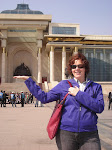
I know I said I wouldn't talk much about my research, but this isn't exactly related, just in the general topic area. Perhaps I've become more perceptive, or there are more people in wheelchairs here than before. Granted, it is summer and I suppose this might be the only time of year when you can be outside comfortably in a wheelchair in Mongolia. However, there are still significant road blocks (literally) to your mobility here, wheelchair or not. For example, the curbs on the sidewalks are nearly one foot high, all of the sidewalks are crumbling (if there is a sidewalk at all), and there are no codes for buildings so they are virtually all inaccessible. Yet, I saw at least 4 people in a couple block radius, in wheelchairs. Two of those people were begging and the other two were selling nuts and candy. When I passed by them, no one seemed to be making any money. The anthropologist inside me would love to interview these people, and begin to break the surface of what it means to be physically disabled in the Mongolian context. I guess I should start with my research and see how that goes before I start planning other projects! The picture above was taken in the 11th district of UB outside a small health care facility. It's the only wheelchair sign I've seen here. It's ironic because it doesn't mean that the building is accessible, I think it's meant to alert cars that people in wheelchairs might be in the street, as that is the only place they can be.










